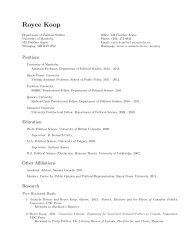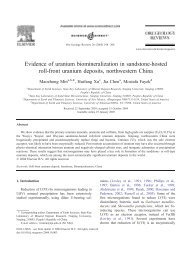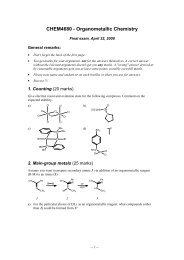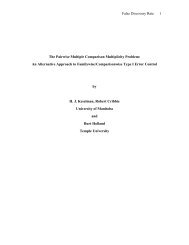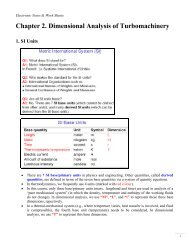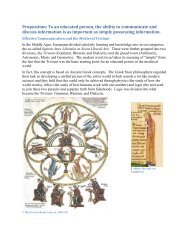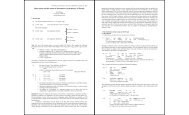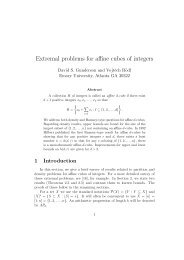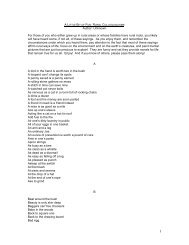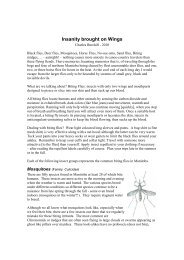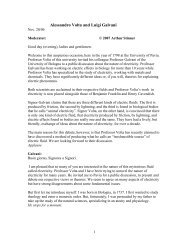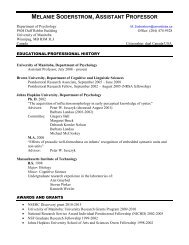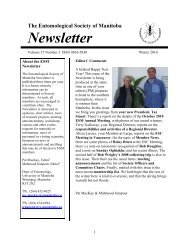Reference Chart for IPA Typography - University of Manitoba
Reference Chart for IPA Typography - University of Manitoba
Reference Chart for IPA Typography - University of Manitoba
You also want an ePaper? Increase the reach of your titles
YUMPU automatically turns print PDFs into web optimized ePapers that Google loves.
Hagiwara – <strong>Reference</strong> <strong>Chart</strong> <strong>for</strong> <strong>IPA</strong> <strong>Typography</strong><br />
version <strong>of</strong> the chart (although composing them results in some pretty ugly symbols). I’ll try to<br />
add them in a later version.<br />
Understanding and using the table<br />
Find the symbol you want to use by looking <strong>for</strong> it in the first column. These are presented in the<br />
order they appear in P&L: all the “a” vowels are together, followed by all the “b” shaped<br />
symbols, etc. Then you can use the codes provided to either insert it into your document. I have<br />
also used this table to refer to symbols in notes and in e-mail with editors and colleagues (“It’s<br />
the rhoticity sign. You know, <strong>IPA</strong> 419, Unicode 734.”)<br />
<strong>IPA</strong><br />
This column presents the <strong>IPA</strong> symbol or diacritic as it appears in the SIL Doulos <strong>IPA</strong>93 font,<br />
which looks a lot like the <strong>of</strong>ficial representation in the <strong>IPA</strong> Handbook(International Phonetic<br />
Association, 1999). Overstriking diacritics are presented with an invisible leading space so the<br />
symbol centers properly. In both the SIL fonts and the Unicode Standard, you type overstriking<br />
characters after the symbol you’re attaching it to.<br />
<strong>IPA</strong>#<br />
This column presents the <strong>IPA</strong> reference number, as indicated in the Handbook (International<br />
Phonetic Association, 1999). Every symbol on the chart has a unique reference number.<br />
SIL<br />
This column is <strong>for</strong> typing in an SIL font. First, switch to the appropriate font font. To enter a<br />
symbol, press and hold the Alt-key while entering the four digit code from the number pad. (In<br />
Mac operating systems, use the Option-key.) Release the Alt-key and the symbol magically<br />
appears. The four digit number must be entered from the number-pad—using the standard<br />
keyboard numbers results in some other kind <strong>of</strong> look-up and the wrong symbol will appear.<br />
You’ll notice that each Alt-code is actually a three-digit number with a leading zero. If you don’t<br />
enter the leading zero, the computer will grab the wrong symbol. There’s probably a reason <strong>for</strong><br />
all this, and if I find out why, I’ll update these notes.<br />
UDec<br />
To put a phonetic symbol on a web page or some other Unicode-compliant GML document, you<br />
must use a Unicode enabled font. Unicode is an international symbol-referencing standard,<br />
which has unique codes <strong>for</strong> <strong>IPA</strong> characters, as well as alphabetic characters <strong>for</strong> just about every<br />
segment-based writing system you can come up with. The trick is finding them.<br />
In a html document (web page source), make sure the string you want will appear in a<br />
Unicode font. This can be accomplished with a (now deprecated) FONT tag (i.e. , with appropriate tag at the end <strong>of</strong> the <strong>IPA</strong> character<br />
string) or with a SPAN or DIV tag and class specified in a style sheet or tag.<br />
Symbol codes start with a leading ampersand “&”. Then to tell the server you’re giving it a<br />
reference number and not a symbol name, you type a number sign “#”. To specify the <strong>IPA</strong><br />
symbol, follow the number sign with the three digit UDec number from this column, followed by<br />
a semicolon “;”. So the Unicode symbol <strong>for</strong> schwa is ə and turned v is ʌ. Where no<br />
number is given, the character is a standard Roman-based character and should be typed using a<br />
standard keystroke, or is not available in the Unicode standard.<br />
page 2 <strong>of</strong> 7



